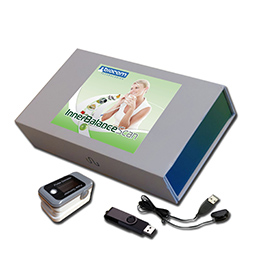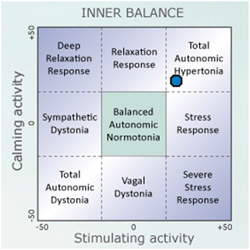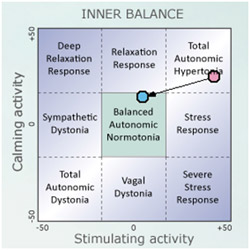Express autonomic function assessment tool - FAQ
|
 |
 |
Inner Balance Scan 2.0
(includes ANS testing software and sensor)
|
|
|
|
Professional heart rate variability assessments in minutes. Instant data analysis and interpretation.
|
|
|
|
Usually ship within 24 hours.
| Description |
Practical use |
Support |
Warranty |
Customer feedback |
|
|
Frequently Asked Questions:
Is there any limit on number of clients and/or tests stored in the product’s database?
No, there are no formal limitations.
Can this product be used to measure autonomic balance before and after chiropractic adjustment?
Yes. The Inner Balance Scan has Pre/Post test mode, which allows for conducting two measurements combined in one test. The results of such test would show autonomic balance for both Pre- and Post- measurements and show its shift from Pre-1 to Post.
What does this report mean and how can I interpret the report for the client?
The Inner Balance Scan produces a fairly simple assessment report.
If you test your client in a single test mode, you get a simple “snapshot” of the client’s current status of the autonomic function. The report shows three diagrams – autonomic balance, regulatory efforts bar and well-being self-assessment indicator.
The autonomic balance diagram shows how active and well-balanced your client’s stimulating and calming functions are.

Ideally healthy individual should produce this diagram with a dot representing actual result in the center of this diagram indicating that both functions are normal and very well balanced. Depending on where exactly the dot appears on this diagram the assessment report produces a specific interpretation indicating what this could mean: it could be a state of relaxation response, or acute stress, or total autonomic dystonia. It gives you some clues what might potentially cause this state and what to do.
The regulatory efforts diagram indicates a state of overall activity of all regulatory mechanisms responsible for body adaptation. The higher this indicator is the better body function is. However extremely high value might be an indication of poor quality of data recording, which is specifically evaluated by the software.
If you test your client in Pre/Post mode and run two tests before and after something, e.g. your treatment procedure, you will get two dots on each diagrams and arrow will show in which direction changes occur.

The report gives you interpretations of both tests is the same way as in single mode. However you will intuitively see what kind of change has occurred in the autonomic balance as a result of your procedure.
Whenever I try to start up Inner Balance Scan on my PC with Windows XP, I get the following error message:
Biocom Technologies Activation Application
Error in Activation Application:
Overflow or underflow in the arithmetic operation.
How do I correct the problems causing this error?
To resolve this problem, try the following:
- Visit Microsoft Windows Update site, check and install all updates available for your system. It automatically detects what you need to install.
- Reinstall Microsoft .NET Framework 1.1 by running the DOTNETFX.EXE program from the Inner Balance Scan CD or download .NET Framework 2.0 from
Microsoft Website.
- Reboot your PC.
Is this report good or bad?
The key element of the Inner Balance Scan assessment report is an autonomic balance diagram which indicates how active and well-balanced your client’s stimulating and calming functions are.

Ideally healthy individual should produce this diagram with a dot representing actual result in the center of this diagram indicating that both functions are normal and very well balanced. Depending on where exactly the dot appears on this diagram the assessment report produces a specific interpretation indicating what this could mean. If we number all 9 segments of this diagram from left to right and from top to bottom, then good results would be if the dot is located in segments 2, 3 or 5. Segments 7, 8 and 9 are considered as not good.
What is the difference between the Inner Balance Scan and the Heart Rhythm Scanner?
The Inner Balance Scan is a low budget tool providing minimum means to get a quick and simple yet accurate and valid assessment of the autonomic function.
The Heart Rhythm Scanner is more sophisticated and comprehensive tool to assess the autonomic function. It gives ability to perform full-scale short-term HRV analysis and get a detailed autonomic assessment report based on single or multiple testing protocols including resting HRV test, orthostatic and slow metronomic breathing challenge tests. It provides a number of ways to show test results in numerical and graphical formats, export measured data to perform additional analysis using known statistical or math tools, and much more.
Please explain to me what the numbers on the assessment report mean?
The Inner Balance Scan produces three simple scores:
- Calming activity – the level of functional activity of the parasympathetic nervous system primarily responsible for body’s relaxation response.
- Stimulating activity – the level of functional activity of the sympathetic nervous system primarily responsible for body’s stress response.
- Regulatory efforts – the overall level of body’s regulatory activity including autonomic nervous system and other slower mechanisms of body regulation such as hormonal activity, major biological rhythms, etc.
The first two scores range from -50 to +50. The third score ranges from 0 to 100. They all are arbitrary units. Their value is directly tied to their normal ranges derived from the population normative database created in a specially designed research study. For the first two scores normal ranges are between -20 and +30. The closer the numbers are to 0, the closer respective parameters to their ideal state. The third parameter has normal range between 40 and 60. Its values less than 40 are considered not good, although values above 60 are good if the quality of test data was not compromised.
How can I use this product in my practice to help my clients?
In some ways it depends on what kind of practice you do.
- Generally this product is used to assess current condition of the autonomic nervous system and its reserve capabilities. It is known that many health problems have the autonomic nervous system involved. The ANS is a central regulatory mechanism that makes all body parts functioning adequately responding to many internal and external factors. The purpose of such regulation is to quickly adapt to changes in the environment. Many diseases start developing when the ANS becomes unable to properly regulate body functions. At that time there are no common clinical symptoms yet, but assessing the autonomic function may show its dysfunction. If this appears consistently it should be considered as an early sign of an onset of some health problem. Although this assessment has a non-specific nature and cannot give a distinctive diagnosis, using it as a screening tool to see if there are any red flags risen by the organism could be very helpful.
- The ANS is sensitive to various types of interventions having effect on its function. So it might be very helpful to use this product to evaluate such effects by either taking test before and after treatment procedures of by regular testing during the course of treatment to see if there is any positive effect of this treatment on the autonomic function.
- Using challenge tests (cardiovascular health and baroreflex sensitivity tests) could be used to find even hidden or subtle problems in the autonomic function. The standard assessment at rest may not show any problem with the autonomic function. But these challenge tests provoke the ANS to respond to certain challenge forcing its adaptive capabilities. So subtle problems with the autonomic function could be found when no other testing methods would show anything wrong.
Tell me about the differences between your products you have so many.
There are a few categories of the product we provide:
- Health assessment systems based on evaluation of the autonomic function:
- Heart Rhythm Scanner 3.0 – a comprehensive health assessment system providing three types of testing capabilities: autonomic balance test (assessing current body’s autonomic function), cardiovascular health test (assessing regulatory reserve of the autonomic nervous system and cardiovascular physiological adaptation capabilities) and baroreflex sensitivity test (assessing health of the core regulatory mechanism of body’s functional adaptation).
-
Inner Balance Scan 2.0 – a simple low budget tool for simple assessment of the autonomic function – its balance and activity level.
- Heart rate variability (HRV) monitoring system:
- HRV Live! – a comprehensive tool for measuring and monitoring the autonomic function in real-time using live HRV analysis. It can be used to assess full dynamics of the body’s autonomic regulation under influence of various interventions.
- Stress management and health improvement tools:
- Heart Tracker Professional – a comprehensive tool providing biofeedback training capabilities based on paced breathing techniques to help teaching patients how to reduce stress and improve various aspects of health (lowering blood pressure, strengthening immune system, improving digestive function, etc.)
- Heart Tracker 3.0 – an inexpensive tool for individual biofeedback training based on paced breathing techniques as indicated above.
|
|


